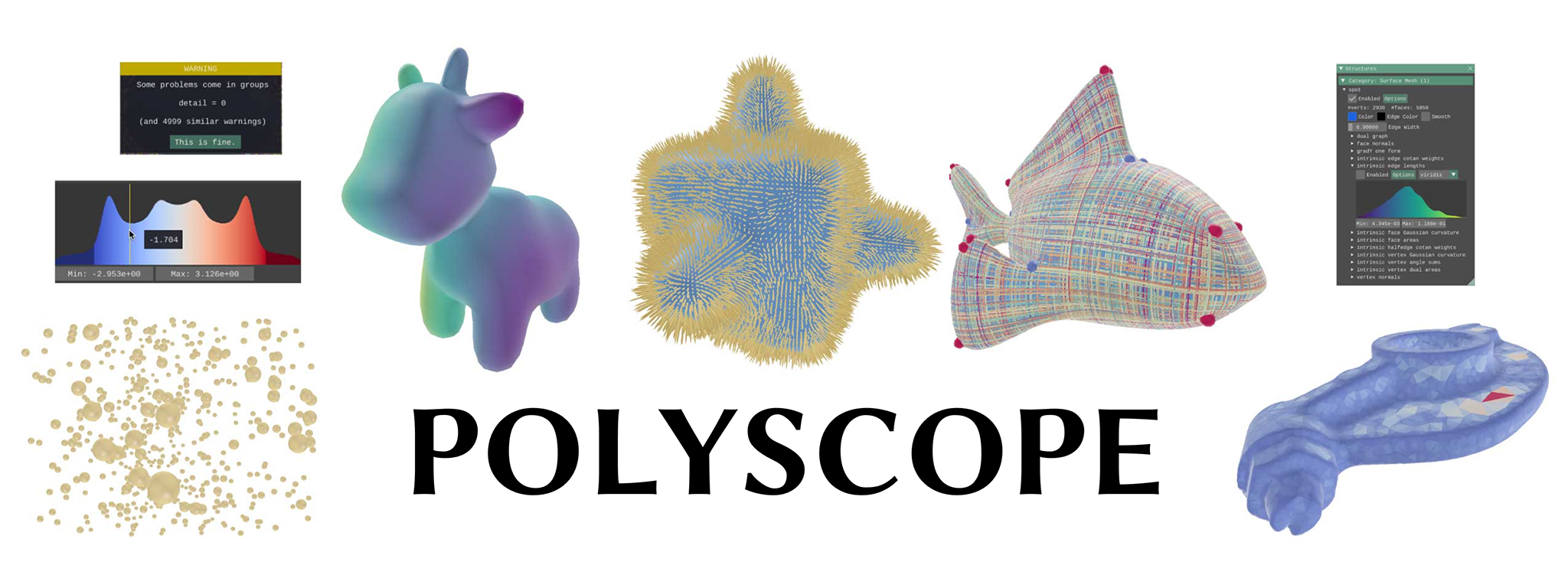ポリゴンMeshや点群などの3Dデータを扱うビューア、インターフェイスを提供するライブラリ。VTKなんかよりもずっと手軽に導入できそう。MITライセンス。
Polyscope
Polyscopeは、Meshや点群などの3Dデータ用のC++/Pythonビューア・ユーザーインターフェイスです。Polyscopeを使えば、プログラムや動的なGUIを通じてデータを登録でき、即座に情報を美しく可視化できます。Polyscopeは軽量になるよう設計されており、プログラム全体の「所有権を奪う」ことはなく、既存のコードベースや一般的なライブラリと簡単に統合できます。Polyscopeが目指すのは、たった1行のコードを通じてデータへの便利なビジュアルインターフェイスの提供することです。
Polyscopeではstructureとquantityのパラダイムを採用しています。structureとは、サーフェスMeshや点群など、シーン内の幾何学的オブジェクトのことです。quantityとは、スカラー関数やベクトル場など、structureに関連付けられたデータのことです。
任意の構造や数量を登録すると、Polyscopeはそれらをインタラクティブな3Dシーンに表示し、可視性の切り替え、データのカラーマッピングとマップの調整、シーン内をクリックして数値を照会する「ピッキング」等、定型的問題を処理できます。
ソースコードはGitHubで配布されている↓
https://github.com/nmwsharp/polyscope
コード例を見ると、3Dデータの可視化GUIをかなりお手軽に実現できるようです↓
Polyscopeでデータを可視化する簡単なワークフローは以下のようになります:
C++:#include "polyscope/polyscope.h" #include "polyscope/surface_mesh.h" // Initialize polyscope polyscope::init(); // Register a point cloud // `points` is a Nx3 array-like container of points polyscope::registerPointCloud("my points", points) // Register a surface mesh structure // `meshVerts` is a Vx3 array-like container of vertex positions // `meshFaces` is a Fx3 array-like container of face indices polyscope::registerSurfaceMesh("my mesh", meshVerts, meshFaces); // Add a scalar and a vector function defined on the mesh // `scalarQuantity` is a length V array-like container of values // `vectorQuantity` is an Fx3 array-like container of vectors per face polyscope::getSurfaceMesh("my mesh")->addVertexScalarQuantity("my_scalar", scalarQuantity); polyscope::getSurfaceMesh("my mesh")->addFaceVectorQuantity("my_vector", vectorQuantity); // View the point cloud and mesh we just registered in the 3D UI polyscope::show();Python:
import polyscope as ps # Initialize polyscope ps.init() ### Register a point cloud # `my_points` is a Nx3 numpy array ps.register_point_cloud("my points", my_points) ### Register a mesh # `verts` is a Nx3 numpy array of vertex positions # `faces` is a Fx3 array of indices, or a nested list ps.register_surface_mesh("my mesh", verts, faces, smooth_shade=True) # Add a scalar function and a vector function defined on the mesh # vertex_scalar is a length V numpy array of values # face_vectors is an Fx3 array of vectors per face ps.get_surface_mesh("my mesh").add_scalar_quantity("my_scalar", vertex_scalar, defined_on='vertices', cmap='blues') ps.get_surface_mesh("my mesh").add_vector_quantity("my_vector", face_vectors, defined_on='faces', color=(0.2, 0.5, 0.5)) # View the point cloud and mesh we just registered in the 3D UI ps.show()Polyscopeは、楽に利用できるよう設計されています。ビルドは簡単で、10行未満のコードで視覚化できます。
C++ではいくつかのテンプレートマジックにより、既に使用しているデータ型をPolyscopeで受け入れることができるでしょう!
関連記事
HerokuでMEAN stack
ZBrushでアヴァン・ガメラを作ってみる 全体のバランス調...
ZBrushで仮面ライダー3号を造る 仮面編 ClipCur...
SIGGRAPH ASIAのマスコット
Google App Engineのデプロイ失敗
『シン・ゴジラ』のコンセプトアニメーションのメイキング動画が...
ZBrushでアヴァン・ガメラを作ってみる 爪とトゲを追加
Adobe Photoshop CS4 Extendedの3...
C++ 標準テンプレートライブラリ (STL)
CGWORLD CHANNEL 第21回ニコ生配信は『シン・...
ZBrushでアヴァン・ガメラを作ってみる 脚のポーズ調整
Unityの薄い本
ラクガキの立体化 進捗
手を動かしながら学ぶデータマイニング
AR (Augmented Reality)とDR (Dim...
Composition Rendering:Blenderに...
Zibra Liquids:Unity向け流体シミュレーショ...
ラクガキの立体化 3Dプリント注文
iOSデバイスのためのフィジカル・コンピューティングツールキ...
Pylearn2:ディープラーニングに対応したPythonの...
映画『ジュラシック・ワールド』のVFXメイキング
UnityからROSを利用できる『ROS#』
Amazon Web ServicesでWordPress
Raspberry Pi
Physics Forests:機械学習で流体シミュレーショ...
NeuralNetwork.NET:.NETで使えるTens...
自前のShaderがおかしい件
OpenGVのライブラリ構成
Houdiniのライセンスの種類
Live CV:インタラクティブにComputer Visi...
SONYの自律型エンタテインメントロボット『aibo』
Google App EngineでWordPress
UnityでARKit2.0
LuxCoreRender:オープンソースの物理ベースレンダ...
イタリアの自動車ブランドFiatとゴジラがコラボしたCMのメ...
ZBrushからBlenderへモデルをインポート
Webサイトのワイヤーフレームが作成できるオンラインツール
cvui:OpenCVのための軽量GUIライブラリ
ZBrushで仮面ライダー3号を造る 仮面編 リファレンス画...
TensorFlowでCGを微分できる『TensorFlow...
Unityの各コンポーネント間でのやり取り
OpenGV:画像からカメラの3次元位置・姿勢を推定するライ...



コメント